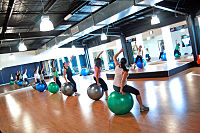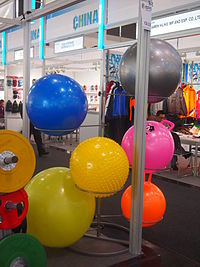Exercise ball



An exercise ball, also known as a Swiss Ball, is a ball constructed of soft elastic with a diameter of approximately 35 to 85 centimeters (14 to 34 inches) and filled with air. The air pressure is changed by removing a valve stem and either filling with air or letting the ball deflate. It is most often used in physical therapy, athletic training and exercise. It can also be used for weight training. The ball, while often referred to as a Swiss ball, is also known by a number of different names, including balance ball, birth ball, body ball, ball, fitness ball, gym ball, gymnastic ball, physio ball, pilates ball, Pezzi ball, sports ball, stability ball, Swedish ball, therapy ball, or yoga ball.
History
The physical object known as a "Swiss Ball" was developed in 1963 by Aquilino Cosani, an Italian plastics manufacturer. He perfected a process for moulding large puncture-resistant plastic balls.[1] Those balls, then known as "Pezzi balls", were first used in treatment programs for newborns and infants by Mary Quinton, a British physiotherapist working in Switzerland. Later, Dr. Susanne Klein-Vogelbach, the director at the Physical Therapy School in Basel, Switzerland, integrated the use of ball exercise as physical therapy for neuro-developmental treatment. Based on the concept of "functional kinetics",[2] Klein-Vogelbach advocated the use of ball techniques to treat adults with orthopedic or medical problems. The term "Swiss Ball" was used when American physical therapists began to use those techniques in North America after witnessing their benefits in Switzerland.[3] From their development as physical therapy in a clinical setting, those exercises are now used in athletic training,[4] as part of a general fitness routine [5] and incorporation in alternative exercises such as yoga and Pilates.[6]
in 2012, Neil Whyte completed the record for the fastest time 10 swiss balls have been jumped across at 8.31 seconds.The record for the farthest jump between two swiss balls was also made by Neil at a distance of 2.3 meters in 2012 [7]
Benefits

A primary benefit of exercising with an exercise ball as opposed to exercising directly on a hard flat surface is that the body responds to the instability of the ball to remain balanced, engaging many more muscles.[8] Those muscles become stronger over time to keep balance. Most frequently, the core body muscles — the abdominal muscles and back muscles — are the focus of exercise ball fitness programs.[9]
A major benefit of using an unstable surface is the ability to recruit more muscle units without the need to increase the total load. The greatest benefit of moving an exercise onto an unstable surface is achieving a greater activation of the core musculature, exercises such as curl-up or push-up performed on an exercise ball.[10] An unstable surface increases activation of the rectus abdominus and allows for greater activity per exercise when compared to a stable surface. Exercises such as a curl-up on an exercise ball yields a greater amount of electromyography (EMG) activity compared to exercises on a stable platform.[11] Performing standard exercises, such as a push-up, on an unstable surface can be used to increase activation of core trunk stabilizers and in turn provide increased trunk strength and greater resistance to injury.[12]
Other uses
Fitness Experts and some Doctors also recommend sitting on an exercise ball instead of an office chair.
This article contains weasel words: vague phrasing that often accompanies biased or unverifiable information. (June 2016) |
This is based on the theory that the abdominal and back muscles are constantly engaged and active in order to maintain proper posture and balance on the ball.[13][14] There is no scientific evidence of those benefits occurring by just sitting without additional exercises.[15][16] However, some people warn against using a Swiss ball as a chair due to ergonomic considerations[17] or biomechanical reasons.[18]
This large plastic ball, known as a "birth ball", can also be used during labour to aid the descent of the fetal head into the pelvis. Sitting in an upright position will also aid fetal positioning and is more comfortable for the woman. Sitting on the ball with arms placed on a bed, table or otherwise sturdy object for support and gently rocking the hips may help the woman during contractions and aid the natural physiological process of birth.[19]
See also
References
- ^ Flett, Maureen (2003). Swiss Ball: For Strength, Tone and Posture. Sterling Publishing Company, Inc. ISBN 1-85648-663-X.
- ^ Klein-Vogelbach, Susanne (1990). Functional Kinetics: Observing, Analyzing, and Teaching Human Movement. Springer-Verlag. ISBN 0-387-15350-0.
- ^ Carriere, Beate; Renate Tanzberger (1998). The Swiss Ball: Theory, Basic Exercises and Clinical Application. Springer. ISBN 3-540-61144-4.
- ^ Hillman, Susan Kay (2005). Introduction to Athletic Training. Human Kinetics. ISBN 0-7360-5292-5.
- ^ Milligan, James (2005). Swiss Ball For Total Fitness: A Step-by-step Guide. Sterling Publishing Company, Inc. ISBN 1-4027-1965-5.
- ^ Mitchell, Carol (2003). Yoga on the Ball. Inner Traditions / Bear & Company. ISBN 0-89281-999-5.
- ^ Glenday, Craig (2013). Guinness World Records 2014. p. 113. ISBN 978-1-908843-15-9.
- ^ Vera-Garcia FJ, Grenier SG, McGill SM (2000) Abdominal muscle response during curl-ups on both stable and labile surfaces. Phys. Ther. 80, 564-569
- ^ Mayo Clinic Staff (August 24, 2007). "Slide show: Core exercises with a fitness ball". Mayo Clinic. Retrieved April 2008.
{{cite web}}: Check date values in:|accessdate=(help) - ^ Clark, K. M., Holt, L. E., & Sinyard, J. (2003). Electromyographic comparison of the upper and lower rectus abdominus during abdominal exercises. Journal of Strength and Conditioning Research / National Strength & Conditioning Association, 17(3), 475–483. doi:10.1519/1533-4287(2003)017<0475:ECOTUA>2.0.CO;2
- ^ Clark, K. M., Holt, L. E., & Sinyard, J. (2003). Electromyographic comparison of the upper and lower rectus abdominis during abdominal exercises. Journal of Strength and Conditioning Research / National Strength & Conditioning Association, 17(3), 475–483. doi:10.1519/1533-4287(2003)017<0475:ECOTUA>2.0.CO;2
- ^ Anderson, G. S., Gaetz, M., Holzmann, M., & Twist, P. (2013). European Journal of Sport Science Comparison of EMG activity during stable and unstable push-up protocols. European Journal of Sport Science, 13(1), 42–48. doi:10.1080/17461391.2011.577240
- ^ Clapp, Jane (2006). Working on the Ball: A Simple Guide to Office Fitness. Andrews McMeel Publishing. ISBN 978-0-7407-5699-3.
- ^ Greenwood-Robinson, Maggie (2007). The Biggest Loser Fitness Program. Rodale. p. 65. ISBN 1-59486-695-3.
- ^ Gregory DE, Dunk NM, Callaghan JP (2006). "Stability ball versus office chair: comparison of muscle activation and lumbar spine posture during prolonged sitting". Hum Factors. 48 (1): 142–53. doi:10.1518/001872006776412243. PMID 16696264.
- ^ McGill SM, Kavcic NS, Harvey E (May 2006). "Sitting on a chair or an exercise ball: various perspectives to guide decision making". Clin Biomech (Bristol, Avon). 21 (4): 353–60. doi:10.1016/j.clinbiomech.2005.11.006. PMID 16410033.
- ^ Ergoweb, Opinion: Balls as Office Chairs a Bad Idea
- ^ Gregory, Diane E. "The Use of Stability Balls in the Workplace in Place of the Standard Office Chair". Centre for Research Expertise for the Prevention of Muscloskeletal Disorders, University of Waterloo. Retrieved Jan 2011.
{{cite web}}: Check date values in:|accessdate=(help) - ^ Wesson, Nicky (2000). Labor Pain: A Natural Approach to Easing Delivery. Inner Traditions / Bear & Company. ISBN 0-89281-895-6.
